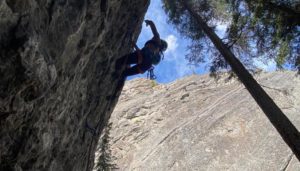Be Careful of Loose Rock This Spring
This is a friendly reminder and heads up to keep an eye out for loose rock this spring and to wear a helmet
 Photo by: Brandon Pullan of rockfall with an anchor from a route
Photo by: Brandon Pullan of rockfall with an anchor from a route
In Canada, we’re lucky because we still get four amazing seasons, each filled with distinctive weather patterns. In winter, everything freezes, even the water within the rock. Water expands in cracks, pockets, holes, slots, chimneys, pods, and just about anywhere, even within tiny breaks which the eye cannot see.
This expansion forces the rock apart, breaking and cracking it. In limestone, where countless cracks and fissures exist, a cold winter can mean the end to a once-solid piece of stone. The effects in more harder rock such as granite or quartzite can result in massive rockfalls.
This freeze/thaw cycle can be potentially dangerous. Every spring, freshly loosened/fractured rock waits to fall, sometimes wind or rain can help it along, other times climbers knock it off. Solid routes from last year can shed rock this year. Ledges will have pebbles and dust from the winter, be careful when throwing for a suspect hold.
If you do knock rock off or see a rock falling, call “ROCK!” to warn anyone in the area. If you hear “ROCK!” tuck against the cliff, keep an eye, get out of the way. Throwing ropes to rappel or pulling ropes to clear the route can also knock rocks down, call “ROPE!”
Test the Hold: To test a rock climbing hold, simply have your weight distributed onto other holds that you’ve deemed safe and give it a few taps with your knuckle and palm. If it sounds hollow, moves or seems sketchy then make a decision about how to move passed it. If there’s chalk on it, then it might be OK, but it could’ve loosened over the winter.
If there are other options to move up then find them to avoid the loose holds. Every route, pitch and move is different and knowing what holds to use takes practice and experience. Before you head up high on potentially chossy stone, know that testing every hold is a quick way to potentially avoid injury.
Wear a helmet. Climbing isn’t worth dying for. Anyone who’s been climbing long enough knows someone who’s had a life-changing incident or died from their injuries. Helmets aren’t about invincibility, they’re about upping your chances of walking away from a head-related accident.
Watch as climbers trundle big blocks from a climb in California.


